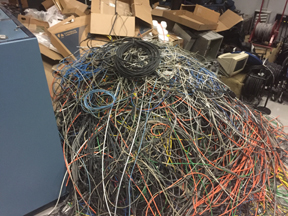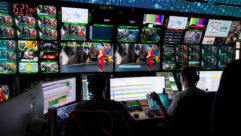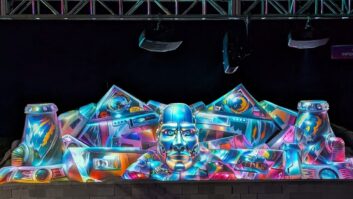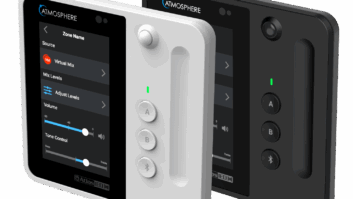
SVC Podcast – Show Notes – Show 181-1
In this edition of the SVC Podcast, Contributing Editor Bennett Liles talks with Steve Obenreder, Sales Manager at RPC Video about the amazing transformation of an aging facility at City Channel Pittsburgh. He takes us through the design, the plan and the muscle work of bringing the old broadcast equipment and the facility itself into the 21st century with a new look, new sound and an all fiber based routing system.
TO GO TO PART 2 OF THIS PODCAST
Links of interest:
- City Channel Pittsburgh – Public, Educational and Government TV
- RPC Video – Pittsburgh, Cleveland, Harrisburg
- A YouTube video on the City Channel Pittsburgh renovation project
- UTAH-100 UDS routing system installed for the project
- Panasonic HE130 PTZ Cameras
Download Podcast Here:
https://s3.amazonaws.com/nb-svc/public/public/181-1_City_Channel_Pittsbu…
Transcript-
This is the SVC Podcast from Sound & Video Contractor Magazine with Steve Obenreder of RPC Video. Show notes and equipment links for the podcast are on the web site of Sound & Video Contractor Magazine at svconline.com.
With its antiquated equipment, the City Channel of Pittsburgh had been described as more a museum than a broadcast facility. They called in RPC Video to modernize their entire technical base. Walls were torn out, routers and other gear installed and this government TV station was born again. RPC Video’s Steve Obenreder is here to tell us about it. Coming at you right now with the SVC Podcast.
Steve, very good having you with us for the SVC Podcast from RPC Video where I believe your official title is Sales Manager.
Yeah, I am the sales manager. I’ve been here a long time, too.
And RPC Video is in Pittsburgh but you also have locations in Cleveland and Harrisburg.
That’s correct.
Well then, you must have plenty to keep you busy with three outfits going at the same time.
We’ve been fortunate to have good people in our offices and good business to carry us through. We’ve been around since – basically since 1986. [Timestamp: 1:22]
Well established and certainly no shortage of experience. I know that when this project came along you got in there for City Channel Pittsburgh, their local government TV channel that provides a great service bringing the workings of local government to the people there. Renovated and modernized their whole TV operation and we have a video link to that. Is this type of project pretty typical of what RPC Video does?
Well, it’s typical in that it represents sort of the broad scope of what RPC Video can do. It was a little atypical that it was spread out over roughly two years from our first budget discussions in early 2014 until the system got commissioned in August of 2016. So it was a long haul because it was a big system that had to stay in operation. There was a lot of time involved in sort of prepping that; you know, getting it ready and trying to find a way to switch from one system to another. [Timestamp: 2:13]
They do an amazing amount and a wide array of programming at City Channel Pittsburgh. Next week we’ll be talking to your partner in this project, their Communications Technology Manager, David Finer, for the story from inside. This was a very substantial upgrade. If you’re knocking out walls, this one has got to be serious. How many different facilities in this building had to be interconnected on this project?
Well, there’s signal infrastructure installed in numerous places in the building, some are active and some are drops for future use. So the active and connected spaces now are of course the engineering and control room suite on the 9th floor of the building, the city council chamber, which is a big focus of the city of Pittsburgh cable channel’s work. That city council chamber is on the 3rd floor of the building. And what they call the city stats room, which is a multiuse meeting space, is on the 6th floor. And then the offices of the cable channel Pittsburgh are also on the 6th floor. Now there’s several other meeting and conference spaces with fiber drops nearby and ready to be added as they needed or as the budget allows. So there’s quite a few and this is a big old building so it was tricky to get around in there. [Timestamp: 3:23]
How old is that building? I think it’s even more antique than some of the equipment they had in it.
[Laughs] It is. It’s hard to believe, but yes it was. The Pittsburgh city/county building, a big old neoclassical beaux-arts design was completed in December of 1917. [Timestamp: 3:38]
Okay. Well, that sounds a little scary right off the bat when you’re talking about this extensive a technical upgrade. Running fiber through it, knocking out walls, re-doing some of the architecture. Did you run into any problems with the building itself?
I’m not sure when we didn’t run into problems with the building. Of course, a building like that was never designed for the type of cabling infrastructure that we need these days. So thankfully there had been some cable access between the floors already in place from the 1982 system that was built there. That was the original cable bureau system they called it, and it was a big system – one of the biggest in the country. So they didn’t have to get through that building then and so thankfully we had some ways to get around the building already, although they weren’t all in place. So this could already be used, but to be sure there were a lot of challenges in getting around that building. [Timestamp: 4:25]
I would think that one of the biggest challenges since you have all the new equipment going in and it’s all using power, did you have to upgrade the power or add more drops to it?
In the control room side yes. Because we helped them redesign that whole space they tore down walls upstairs and turned what was basically three small control room spaces into one large, more modern control room space. So there was a whole new power brought into that area there. Even though our power needs aren’t astronomical, the power was a little antiquated so there are new power drops there. Now that was handled by the city’s people themselves, they have their own electricians and such, but we outlined all that and spec’d that and they put that in for us. The city council chamber not so much. That had been redone for power a few years ago because they added some lighting and things. So power needs down there didn’t cause a problem. [Timestamp: 5:12]
And in the city council meeting room there they record the meetings. What did you specify in there to record those meetings?
Specifically there’s a Biamp Tesira server in there running Dante audio between the 6th floor and the 9th floor. So they have multiple channels of audio for all the microphones for the council members, for the council president, for guests and speakers in there, for the public when the public has to speak. That was all redone. It was an old analog system before that was sort of hobbling along. And for video there are four Panasonic HE-130 cameras in there, pan-tilt-zoom cameras, that work very well. They also are wired to be able to roll in their studio cameras if they need extra cameras in there or they want a human-operated camera for some specific purpose there. The cable bureau, as we call it, their main charter is to show city council meetings. Now they do hundreds of other productions, but that’s one of the things they have to do by their charter. So those are all broadcast live over two – a Horizon cable channel and a Comcast cable channel – as well as streaming live on the web site for the city. They do back those up and record them, so for recording they use Grass Valley T2 servers. They have several of those down there. I think there’s four or five of them. And then for scheduled playout they have two channels of Leightronix, UltraNEXUS HD, and there’s also a large SAN system there from Scale Logic that they use for storage and editing and that kind of work. [Timestamp: 6:43]
And I’m figuring, in that old building they had no fiber run anywhere.
No, there was no fiber there. The original cameras, or the older cameras, were all multicore cameras – big CCU cables that ran between the floors. So this was new fiber from the council chambers up to the control room on the 9th floor and various other places around the building. [Timestamp: 7:04]
Yeah, running all of that stuff through that old building must have been an adventure in itself.
Here’s how that worked. Our PC didn’t actually pull the fiber. We designed the fiber system, we supervised it, but the city has an electrical contractor that knows that building pretty well and they had worked in there a number of times. And they were the guys that were chosen, thankfully, because they were set up to do that kind of work. And I believe there was some fiber in that building for other purposes, not for audio/visual or for video, but for network and some things in some places. So that electrical contractor did a good job of crawling through the building and getting things where we needed them to get. But it was not easy even for that. [Timestamp: 7:44]
And the heart of the distribution system is the Utah-100 UDS router. Was there a particular reason why you decided to go with that one?
Well, the original 1982 system had a large Utah router and it still worked fine. But it was analog composite video, which of course couldn’t work for this upgrade. So there really wasn’t much discussion of another router for that. Utah had proven itself very worthy and the folks from Utah that we dealt with, I’m telling you, were very, very good to work with. It was a good choice all around. [Timestamp: 8:14]
No better advertisement than something that just keeps working for that long.
Yes, that’s right.
What did you provide for an audio mixer for them in there? I noticed from the video that it looks like they were using a Yamaha PM-2000 before.
Yes. There was a big, old 32-channel PM-2000 that actually someone bought. They offered that stuff up for sale through some government channel and somebody bought that. So we wanted, and they wanted, to have sort of that same feel. A lot of what they do, especially during council meetings, is ride faders. People talk all over the place during those council meetings. So we wanted a mixer that sort of had that approach to it, that someone can sit down and easily say hey, I can run this for most operations. So we chose the Soundcraft Si Performer 32. It had 32 faders, so they were comfortable with that. It’s easy to do basic things on it for almost anyone, but there’s a lot of digital memories and digital features on that mixer that make it work very nicely if they want to dig a little deeper and do some of that kind of work with it too. [Timestamp: 9:17]
Sometimes I guess you break in new crew people on the audio job but that can actually be more complicated than the picture side of it.
That’s right. That’s right. So we wanted this to, when they sat down at it, not to be fearful that it was going to be too hard to learn and it’s worked fine. It’s worked out just fine. [Timestamp: 9:31]
I know there are some great people working there and they do it for the love of the job. This was a big project and it took a while to do so what have you got coming up for RPC Video? Do you do a lot of control rooms? Have you got any more of those coming up?
We do. We have two or three more nice TV production systems on the docket, a couple of large AV installations and such. But as we work our way in the future we like to say we’re working away from HDBaseT. We’re looking to continue with more fiber distribution for mid to large projects, looking at AV over IP. So our future, we think, is packed with lots of fun things to learn and integrate. [Timestamp: 10:07]
Well, running into one of these big projects where you have to actually change the building around has got to at least keep things from getting dull.
There was not a dull moment throughout this whole thing, believe me. There was unbelievable amounts of cable in those ceilings. I’d never seen so much cable. A lot of it was original. A lot of it had been added. And none of it – I mean none of it – was documented any more. So our engineering guys had to go cable by cable and test them and see where they went and figure out whether they could remove them or whether they were needed. Remember, they had to stay on the air all the time so they had to pick through thousands of cables everywhere to find out what worked and didn’t work and remove them and reroute them if they needed to. That part was tedious and it went on for months – I mean months. So it was crazy. We never did a job quite like that where you had so much deconstruction to do before you could start to build something. [Timestamp: 11:02]
The next couple of control room projects may be almost restful compared to this one.
They’ll seem easy, that’s for sure.
You had a great local crew there to work with at City Channel Pittsburgh with all of David Finer’s people.
David was wonderful to work with. We thought that because this was going to stretch out – and we told him this could take a long time. And he was so enthused about finally replacing that ancient system that he was patient with us and as we poured through this he was great to work with. I mean great to work with. [Timestamp: 11:28]
Well, we appreciate your time on telling us about this one. Steve Obenreder from RPC Video in Pittsburgh and the complete renovation of their local government TV operation. I’m sure you did a fine job on it and thanks for telling us the story.
Bennett, thank you very much for having us on. I appreciate that very much.
Thanks getting with us on today’s SVC Podcast. Show notes and equipment links are on the website of Sound & Video Contractor Magazine at svconline.com. Next week we’ll have Dave Finer, Communications Technology Manager at City Channel of Pittsburgh to complete the story. Get back with us and we’ll see you then.










